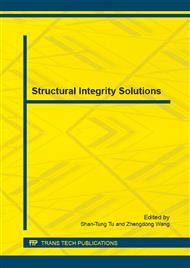p.226
p.236
p.244
p.251
p.261
p.266
p.272
p.279
p.285
The Study on EMAT Applied in Nondestructive Testing of Elevated Temperature Material
Abstract:
Electromagnetic acoustic transducers (EMATs) has overcome many disadvantages of the traditional piezoelectric ultrasonic sensors and can be applied in elevated temperatures and on-line inspection. In an EMAT testing system, the tested material and EMAT itself make up a whole system. So the performance of EMAT is closely depended on some physical parameters of tested material. On the other hand, characteristic parameters of metallic materials are closely related to temperature, such as density, modulus of elasticity, electrical conductivity and magnetic permeability. As the temperature increases, the density of the metal material is reduced, the elastic modulus is reduced, the electrical conductivity is decreased, the magnetic permeability has a consistent increasing trend until the Curie point. Thus the EMAT detection performance affected by the change of temperature should be considered. This paper studied the effects of temperature on EMAT testing. Three materials of 20 # steel, Q235 and 16MnR were investigated. Testing temperature varies from 26 °C to 500 °C. The results show that under elevated temperature condition, EMAT echo signals still have a good waveform and stability. Meanwhile, signals are attenuated less than 2dB. It proved that the EMAT technique has a good steady performance in elevated temperature.
Info:
Periodical:
Pages:
261-265
Citation:
Online since:
April 2015
Authors:
Price:
Сopyright:
© 2015 Trans Tech Publications Ltd. All Rights Reserved
Share:
Citation:


